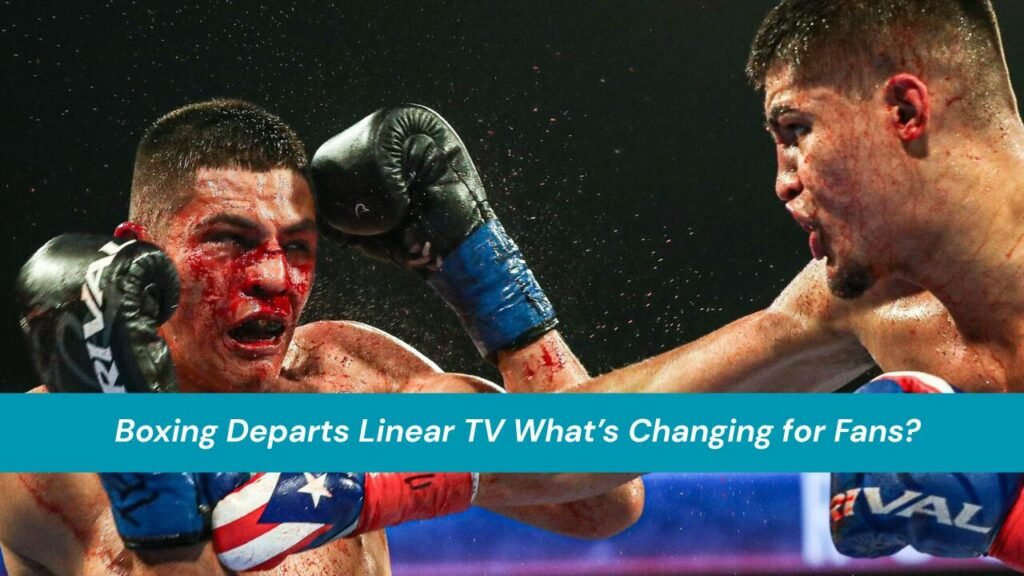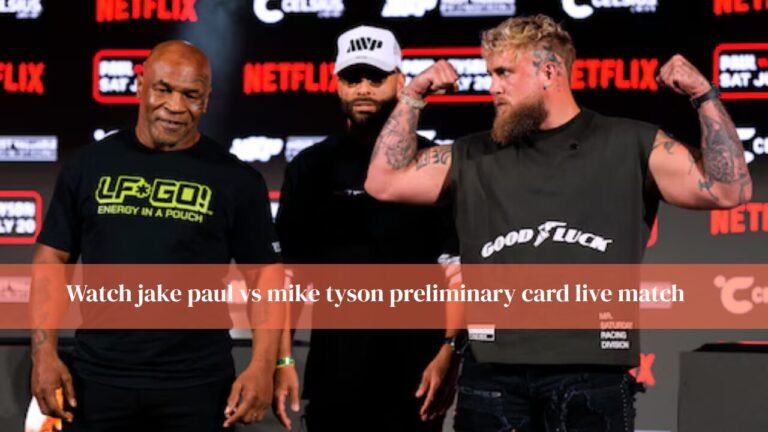As ESPN concludes its eight-year partnership with Top Rank Boxing, the sport’s presence on traditional linear TV has come to a halt. This major shift reflects broader changes in the media industry, with digital platforms becoming the dominant force in how sports content is consumed. As the sports world increasingly embraces streaming services, boxing is following suit. The days of cable and satellite TV being the primary way for fans to watch their favorite bouts are over. The transition to streaming platforms represents a pivotal moment in boxing’s evolution, and in this article, we will explore Boxing departs linear TV, the reasons behind this shift, what it means for the sport’s future, and how fans can stay connected to their beloved sport in the age of digital media.
The End of an Era ESPN and Top Rank’s Split
The night of July 27, 2025, marked a significant milestone in boxing history. Xander Zayas, one of the sport’s rising stars, triumphed over Jorge Garcia at Madison Square Garden in New York. However, this fight wasn’t just another bout; it represented the official end of Top Rank’s eight-year run on ESPN. The partnership between Top Rank and ESPN was one of the most significant in recent boxing history. ESPN had been a major broadcaster for the sport, bringing boxing to millions of viewers. But in February 2025, ESPN decided not to renew its contract with the promotion. This decision was confirmed after Zayas’ victory, and since then, Top Rank has been left without an active broadcast deal.
Bob Arum, the CEO of Top Rank, has expressed his intention to seek new broadcast opportunities, planning to divide the rights across multiple platforms. However, as of late July 2025, no new deals have been finalized. This leaves boxing in a precarious situation where the sport no longer has a strong foothold on traditional TV networks. The decision to part ways with Top Rank marks the culmination of a trend that has been unfolding for several years. ESPN’s exit from boxing broadcasting is only the latest development in a broader shift away from linear TV for major sports promotions. Over the past decade, the traditional TV model for sports broadcasting has come under increasing pressure, as digital platforms provide more flexible and accessible viewing options.
Why Boxing is Leaving Linear TV The Changing Media Landscape
The departure of ESPN from boxing broadcasting is part of a much larger trend in the sports media landscape. Several key factors have contributed to the shift away from traditional TV networks in favor of streaming platforms. One of the most important drivers of this shift is the changing behavior of sports fans. The rise of streaming services like Netflix, Amazon Prime Video, DAZN, and others has radically changed how people consume sports. Instead of adhering to rigid TV schedules, fans now have the freedom to watch events on-demand, whenever and wherever they choose. This flexibility is especially attractive to younger audiences who value convenience and accessibility.
From a financial perspective, the traditional TV model has also become less sustainable for sports promoters. Linear TV networks require significant investments in production, broadcasting, and distribution, while streaming services often provide more cost-effective solutions. For boxing promotions, the appeal of streaming lies in the lower production costs and the ability to reach a global audience. With fewer barriers to entry, boxing can expand its reach without being tied to the constraints of traditional television.
Over the past few years, other major sports networks have also exited the boxing business. HBO, once a major player in boxing broadcasts, aired its final fight in 2018. Showtime, another giant in sports media, shuttered its boxing division in 2023. Premier Boxing Champions, one of the sport’s largest promotions, had its deals with Fox Sports and Showtime expire in 2022. Since then, it has partnered with Amazon’s Prime Video for future events.
Golden Boy Promotions, founded by legendary boxer Oscar De La Hoya, also made the move to streaming, exclusively signing deals with sports streaming service DAZN. Even Jake Paul’s Most Valuable Promotions, which rose to prominence through his viral fights, has signed a deal with Netflix, further highlighting the trend of boxing embracing the digital future. This migration to streaming platforms is not unique to boxing. Other sports, including professional wrestling and mixed martial arts, have seen similar transitions. The most notable example of this shift is UFC’s embrace of digital streaming, with its broadcasts available via ESPN+ and other streaming platforms. The move away from linear TV has become a trend in sports broadcasting, as fans increasingly demand access to content on their own terms.
The Future of Boxing How Digital Platforms are Shaping the Sport
As boxing transitions away from linear TV, streaming services are emerging as the future of the sport. The ability to stream boxing events allows fans to watch live matches, on-demand content, and exclusive behind-the-scenes footage at their convenience.
The Role of Streaming Services in Boxing’s Future
Streaming services offer a host of benefits for both fans and boxing promoters. From a fan perspective, the ability to watch matches at any time and from any location is a major selling point. Additionally, streaming platforms often provide access to exclusive content such as fighter interviews, documentaries, and pre-fight build-up. These features offer a more immersive and personalized experience than what was traditionally available on linear TV.
For boxing promoters, the shift to streaming platforms offers a more sustainable and financially viable model. Streaming services provide a broader global audience, allowing promotions to reach fans from all corners of the world. The ability to stream events in multiple languages and regions also opens new revenue streams for the sport. Several major platforms are leading the charge in bringing boxing to digital media. DAZN has already established itself as a dominant force in sports streaming, while Amazon Prime Video’s Prime Video Sports division is rapidly expanding its catalog of live sports events. Even Netflix, primarily known for its original TV shows and films, has entered the sports streaming market, highlighting the growing interest in digital broadcasting.
Could ESPN Return to Boxing? The Possibility of TKO Boxing
Despite the exit of ESPN from traditional boxing broadcasts, there is still a slight possibility that the network could re-enter the sport through the UFC-backed TKO Boxing promotion. ESPN’s deal with the UFC is set to expire in December 2025, and discussions are underway regarding ESPN’s continued involvement in UFC events. If these talks lead to a partnership with TKO Boxing, ESPN could once again become a significant player in the sport, but this would likely be through streaming rather than Boxing departs linear TVV.
While ESPN’s involvement in TKO Boxing could signal a return to combat sports, it’s important to note that the future of boxing on traditional TV is uncertain. As media consumption continues to shift towards digital platforms, it is unlikely that the sport will return to its former place on linear TV. ESPN’s potential partnership with TKO Boxing would likely focus on digital streaming rather than traditional broadcasts, reflecting the changing nature of sports media consumption.
How Boxing’s Shift Impacts Fans and the Industry
The move from linear TV to digital streaming will have a significant impact on boxing fans and the sport’s broader ecosystem. While some fans may miss the familiar experience of watching boxing on traditional TV, the shift to streaming opens up new opportunities for the sport.
Benefits for Fans
On-demand access means fans will no longer be tied to specific broadcast schedules. They can watch matches at their convenience, whether on a mobile device, laptop, or smart TV. Streaming platforms allow boxing promotions to reach a global audience, enabling fans from different countries to access the sport in ways that were previously unavailable. With streaming services investing heavily in sports content, fans can expect exclusive access to behind-the-scenes footage, interviews, and other features that enhance the viewing experience.
Challenges for Boxing
While streaming provides greater flexibility, it may also create barriers for fans who are not familiar with digital platforms or who don’t have access to high-speed internet. Boxing has a long history of being broadcast on TV, and some fans may be resistant to change. The sport’s transition to digital media may alienate certain segments of its audience.
FAQs
Why has boxing moved away from Boxing departs linear TV?
Boxing has moved to streaming due to the changing media landscape, with fans increasingly preferring on-demand content. The rise of platforms like DAZN, Amazon Prime Video, and Netflix has made it easier for fans to watch boxing without being tied to traditional TV schedules.
Where can I watch boxing now?
Major boxing events are now available on streaming platforms like DAZN, Amazon Prime Video, and Netflix. These platforms offer a more flexible and accessible way for fans to enjoy the sport.
Is ESPN going to return to boxing?
While ESPN has ended its relationship with Top Rank, there is a possibility that the network could return to boxing through a partnership with TKO Boxing, a UFC-backed promotion. However, this would likely involve streaming rather than traditional TV broadcasts.
Conclusion
Boxing departs linear TV marks a new chapter in the sport’s history. As digital streaming platforms continue to rise in popularity, boxing is following suit, offering fans a more flexible and accessible way to engage with the sport. While this shift may take some getting used to, it represents an exciting opportunity for the sport to reach new audiences and expand its global footprint.
As boxing continues to embrace the digital age, fans will need to adapt to new viewing platforms. The sport may have left linear TV behind, but its future is bright in the world of streaming. With greater access and exclusive content, boxing fans can look forward to a new era of sports consumption that offers both convenience and excitement. Visit boxing essential to explore more.




